10 RULES OF SOCCER: Basic Rules & Offsides Explained
If you’re searching for the rules of soccer – this is for you.
Whether you’re a seasoned player or just starting to learn the ropes, it’s always important to understand the rules of the game.
In this post, we’ll dive into the basic rules of soccer, including the ever-so-important offside rule.
If you’re a fan of the beautiful game, or simply want to learn a bit more about it, this post will provide a comprehensive overview of the rules of soccer.
So grab a drink, settle in, and let’s get started on understanding the amazing game of soccer!
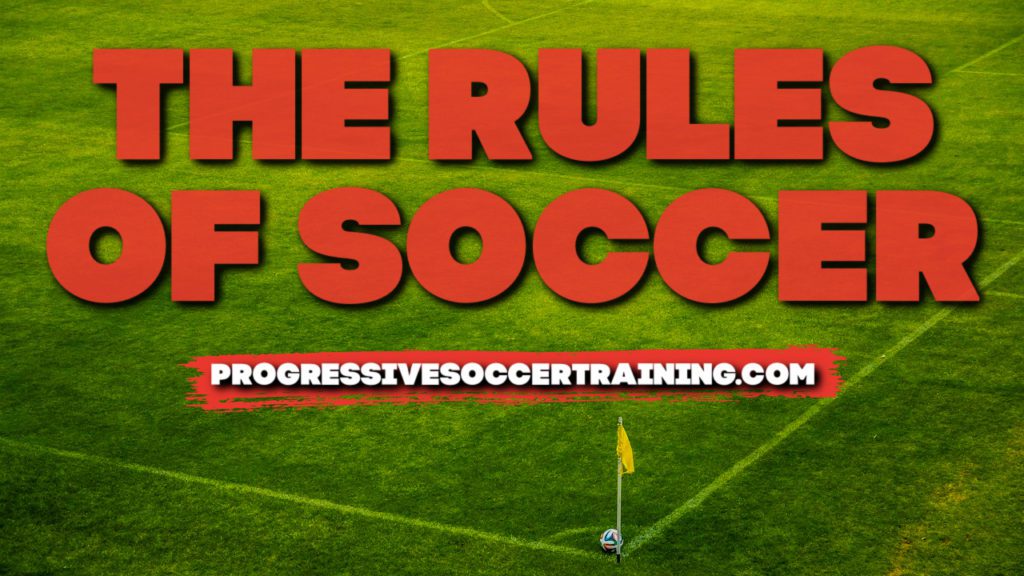
Rules Of Soccer
To explain the rules of soccer very simply….
Soccer is a sport played by two teams of 11 players each on a rectangular field with a goal in the center of each end.
The objective of the game is to score points by getting the ball into the opposing team’s goal. Points can only be scored by the attacking team and can only be scored when the ball completely crosses the goal line between the goal posts and under the crossbar.
Players can move the ball by kicking it or by striking it with any part of their body except their arms and hands, which are only used to play the ball when executing a throw-in or a goal-kick.
The team with the most points at the end of the game wins, and if the score is tied, the game can end in a draw.

10 Basic Rules Of Soccer
Here are the rules of soccer explained in a simple and easy-to-understand manner! I’ll explain some rules of soccer (including the confusing offside) in more detail later in this post.
10 Basic Rules Of Soccer (Explained Easily)
- Teams: Soccer is played by two teams of 11 players each, with one player designated as the goalkeeper.
- Field: The game is played on a rectangular field, with two goals located in the center of each end.
- Objective: The objective of the game is to score points by getting the ball into the opposing team’s goal.
- Scoring: Points can only be scored by the attacking team and can only be scored when the ball completely crosses the goal line between the goal posts and under the crossbar.
- Ball movement: Players can move the ball by kicking it or by striking it with any part of their body except their arms and hands. Which are only used to play the ball when executing a throw-in or a goal-kick.
- Game duration: A typical game of soccer lasts for 90 minutes, split into two halves of 45 minutes each, with a 15-minute break in between.
- Offsides: Offsides occur when a player is in a position closer to the opponent’s goal than the ball and the second-to-last defender (not including the goalkeeper) at the time the ball is played.
- Fouls: Players are not allowed to push, tackle, or make contact with an opponent in a way that is considered unfair. If a player commits a foul, the opposing team is awarded a free kick.
- Yellow and red cards: Referees can issue yellow cards to players for unsportsmanlike behavior. A player who receives two yellow cards in one game is automatically given a red card, which results in their expulsion from the game.
- Penalties: If a foul is committed inside the penalty area by a defending player, the attacking team is awarded a penalty kick. Which is taken from a designated spot 12 yards from the goal and is an opportunity for the attacking team to score a goal with only the goalkeeper defending.
That’s it! With these basic rules of soccer, you’re well on your way to understanding and enjoying the beautiful game. Whether you’re watching a game or playing it, I’m sure you’ll have a great time!
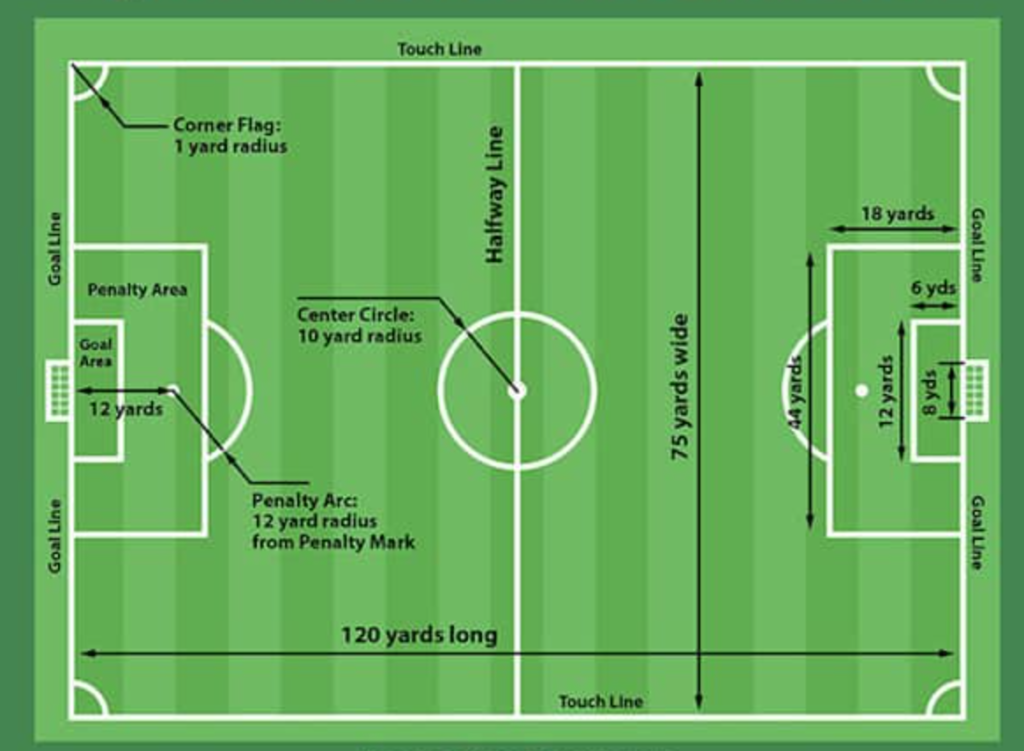
Rules Of Soccer – OFFSIDES
The offside rule in soccer can seem complicated at first, but with a little bit of explanation, it becomes easy to understand.
The offside rule is in place to prevent players from simply hanging around the opponent’s goal. Waiting for the ball to be passed to them. Which would make for an unbalanced and boring game.
The offside rule states that a player cannot be involved in active play (i.e., cannot touch the ball or interfere with an opponent). If they are closer to the opponent’s goal than both the ball and the second-to-last defender (not including the goalkeeper) at the time the ball is played.
Imagine a line running parallel to the goal line and passing through the second-to-last defender (not including the goalkeeper). If an attacking player is on the same side of this imaginary line as the ball, they are not in an offside position and are free to be involved in active play.
However, if an attacking player is on the opponent’s side of the imaginary line, they are in an offside position and cannot be involved in active play until they retreat back behind the line.
Additionally, players cannot be called offside if they are on their own half of the field. If they are level with the second-to-last defender, or if they receive the ball directly from a goal kick, a corner kick, or a throw-in.
The offside rule can be a bit tricky to understand at first, but with a bit of practice, you’ll soon be able to spot offside positions with ease! And don’t worry, even seasoned players and referees get it wrong sometimes. Don’t be too hard on yourself if you don’t get it right away.
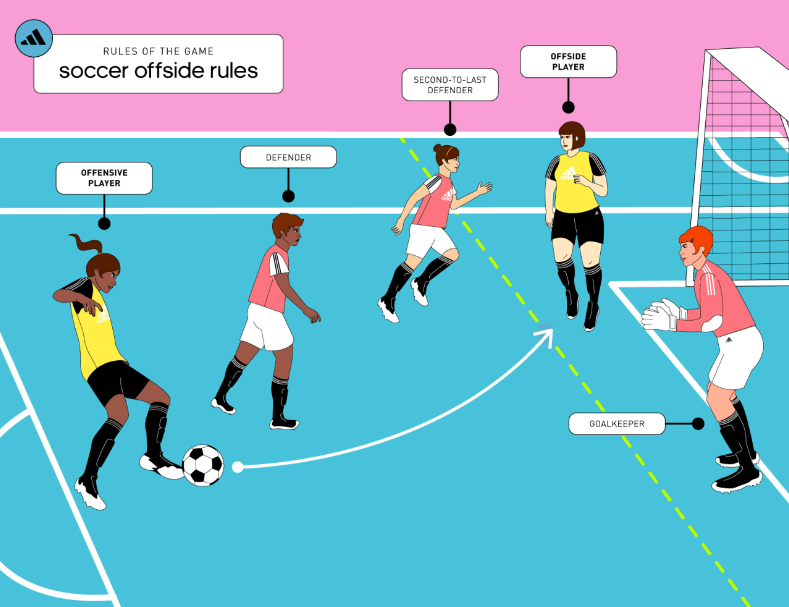
Rules Of Soccer – OUT OF BOUNDS
The out of bounds rule in soccer is an important aspect of the game, and it’s pretty simple to understand!
- The field of play is marked by the sidelines and the goal lines. If the ball goes outside of these lines, it’s considered out of bounds.
- When the ball goes out of bounds, the game is stopped and a throw-in or corner kick is awarded to the opposing team.
- A throw-in is awarded when the ball goes out of bounds on the sidelines. The player who will take the throw-in must have both feet on the ground and throw the ball with both hands over their head, using a smooth motion.
- A corner kick is awarded when the ball goes out of bounds on the goal line and was last touched by the defending team. The attacking team takes the corner kick from the corner nearest to where the ball went out of bounds.
- If a player deliberately kicks the ball out of bounds, a direct free kick is awarded to the opposing team.
These are the basic rules for out of bounds in soccer. Remember, the main idea is to keep the ball in play and to keep the game flowing smoothly. By following these rules, you’ll be able to play soccer in a safe and fair way. Have fun!
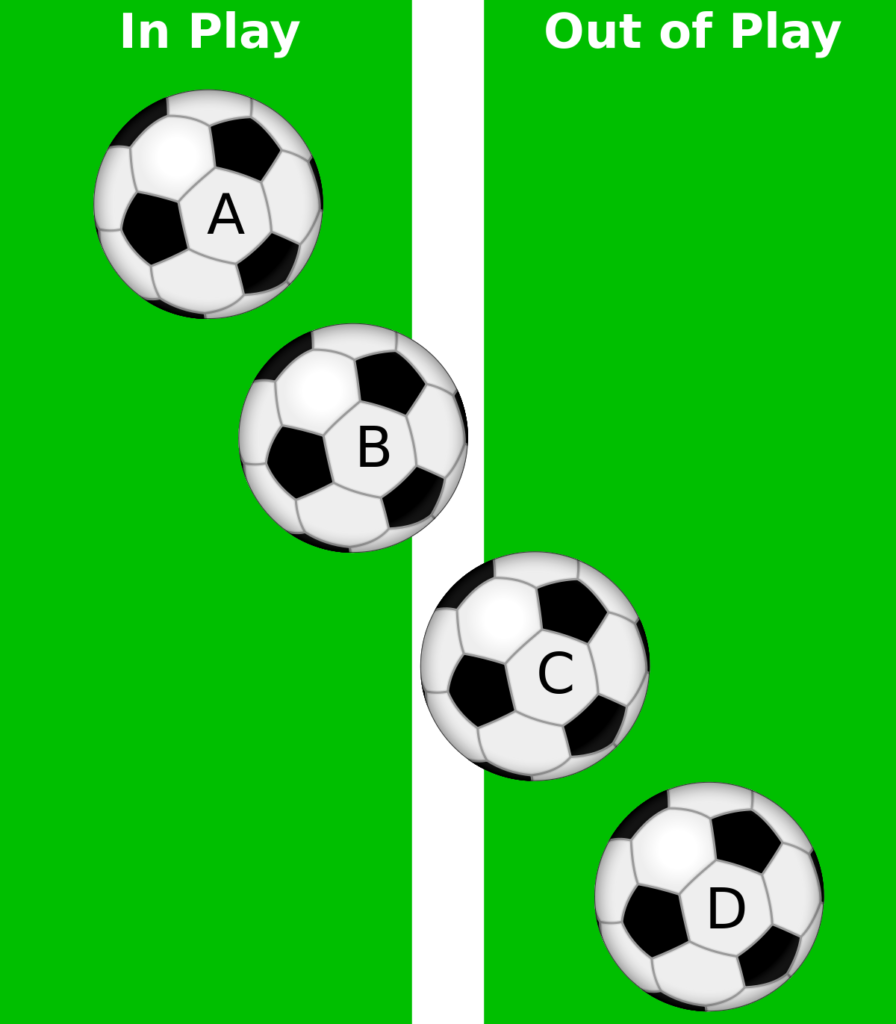
Rules of Soccer – Game Differences?
there are some differences in the “rules of soccer” between men’s, women’s, amateur, and youth soccer, but the basic principles remain the same. The differences mainly relate to details such as field size, game duration, and ball size.
Here’s a brief overview of some of the differences:
- Men’s rules of soccer: Men’s soccer is played by teams of 11 players and is governed by the laws of the game as established by the International Football Association Board (IFAB). Men’s soccer games typically last for 90 minutes, split into two halves of 45 minutes each.
- Women’s rules of soccer: Women’s soccer is also played by teams of 11 players, but some variations in the rules and regulations are made to account for differences in physical abilities between men and women. Women’s soccer games typically last for 80 minutes, split into two halves of 40 minutes each.
- Amateur and youth soccer: The rules for amateur and youth soccer can vary depending on the league and the country in which the game is being played. For example, in some leagues, games may be shorter, fields may be smaller, or fewer players may be used. The objective is to provide a fun and enjoyable experience for players of all ages and abilities.
- Small-sided soccer: Small-sided soccer is a variation of the traditional 11-a-side game and is typically played with fewer players and on a smaller field. This variation of the game is often used for youth and recreational leagues and provides a more fast-paced and dynamic experience.
In all cases, the basic rules of soccer, such as the objective of the game, how the ball is moved, and the prohibition of fouls, remain the same. The differences between the various forms of soccer serve to accommodate the different needs and abilities of players and to provide a fun and enjoyable experience for everyone involved.
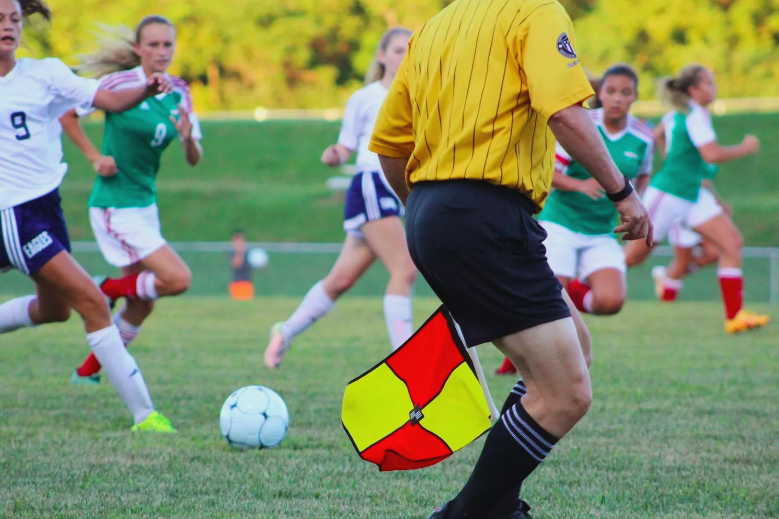
Rules Of Soccer For Kids
By now you should have a clear understanding of the basic rules of soccer. If you’re looking to help your child get started in soccer, here is a list of rules for young soccer players to help them have fun, work hard, and help their teammates:
- Have a positive attitude: Always have a positive and supportive attitude towards your teammates and coaches. Encourage your teammates and help them to have fun on the field.
- Listen to the coach: Your coach is there to help you become a better player and to help your team succeed. Be sure to listen carefully to their instructions and do your best to follow them.
- Respect the officials: Referees and linesmen play an important role in the game of soccer. They make decisions that help keep the game fair and safe for everyone. Be sure to respect their decisions, even if you don’t agree with them.
- Be a good teammate: Help your teammates by encouraging them, passing the ball to them, and working together as a team. Remember, soccer is a team sport and your success is dependent on the success of your team.
- Practice good sportsmanship: Soccer is a competitive sport, but it’s important to always practice good sportsmanship. Win or lose, shake hands with your opponents and thank the officials for their time.
Kids will gain so much from the sport of soccer throughout their life. It’s important to have fun but always try to win. Soccer is a sport that requires a lot of effort and hard work. Do your best to give 100% effort in every game and practice.

Rules Of Soccer For Dummies / Beginners
The rules of soccer for dummies / beginners are the same as everyone else. I would encourage you to stick with soccer. Keep playing, learning more about the game, and falling in love with this beautiful sport.
Here are some tips for beginners to help you play soccer better:
- Work on your skills: Soccer is more fun when you have a good technical foundation. Practice your dribbling, first touch, and passing skills. The better you become, the more fun the game becomes.
- Stay focused: When playing soccer, it’s important to stay focused on the game. Pay attention to what’s happening around you and be ready to react quickly.
- Communicate with your teammates: Communication is key in soccer. Talk to your teammates on the field and let them know what you’re thinking. This will help you work together and play as a team.
- Stay in shape: Soccer is a physically demanding sport, so it’s important to stay in good shape. Make sure you’re eating healthy and exercising regularly.
- Have fun: Above all, the most important thing is to have fun! Soccer is a great game, and playing it with a positive attitude and a smile on your face will make the experience even better.
These are just a few tips to help beginners play soccer better. By following these guidelines, you’ll be well on your way to becoming a better soccer player and enjoying the game even more!

Rules of Soccer (VIDEO)
To help summarize everything you’ve learned so far.
Here’s a helpful video explaining the rules of soccer in a way that you can see more clearly.
In this video, we’ll go over all the basic rules of soccer, from how to start the game to what constitutes a foul. We’ll also discuss offside, throw-ins, corner kicks, and more. So sit back, relax, and get ready to learn everything you need to know about the rules of soccer!
Rules Of Soccer EXPLAINED
I hope this blog post has provided you with a clear understanding of the basic rules of the game and how to play it fairly and safely. Knowing the rules of soccer is essential for having a great time on the field.
Remember, the objective of the game is to score goals, but it’s also about teamwork, sportsmanship, and having fun. So go out there, enjoy the game, and always play by the rules!
And…
If you want to become a better soccer player, continue training with me.

The Next Step
If you found this article helpful, you’ll absolutely love The Soccer Success Planner.
Are you tired of feeling like you’re not making progress in your soccer skills? Do you want to have a more organized and effective training routine? Do you struggle with setting and achieving your soccer goals?
If you answered yes to any of these questions, then the Soccer Success Planner is perfect for you. This planner will help you stay motivated, focused, and on track towards achieving your soccer goals. And it’s completely customizable to fit your unique needs!
Use the planner to set clear goals, track your progress, and stay accountable to yourself. With helpful prompts and exercises, you’ll be able to identify your strengths and weaknesses, plan your training sessions, and maximize your performance on the field.
Download your free copy now and start taking control of your soccer success today! You can download it here – Soccer Success Planner

Need Faster Improvements!?
Not getting better at soccer? Confused about how to train effectively? Maybe you’re worried that you won’t be properly prepared for your next big opportunity? Or you just want to standout and actually feel respected by your teammates, coaches, and friends?
Whatever struggles you’re going through, The Online Soccer Academy is the best solution to help you overcome obstacles and achieve goals. Thousands of satisfied players have already taken the next step and achieved incredible results in record time.
With expert coaching, structured player development systems, and easy-to-follow training routines, it’s guaranteed to elevate game.
Join today and start experiencing the transformation you’ve been waiting for!
Get more information here – Online Soccer Academy

About The Author
If you don’t know about me…
I used to be a soccer player who struggled with self-confidence. I felt slow, weak, and unmotivated. My coaches didn’t pay much attention to me, my friends laughed at my lack of skills. At one point, I even became so discouraged that I quit the sport altogether.
Enough was enough. I decided to take control of my own development and set out on a journey to become a better soccer player. This path led me on an incredible journey of self-improvement.
I went on to win league and goal-scoring titles, earn awards, lift trophies, and received a college scholarship. I’ve even earned international caps for my country.
I started sharing my knowledge with others and teaching them how to become the best soccer players they could be. My YouTube channel grew to over 500,000 subscribers.
In addition, I coached for several youth clubs in my local city, and even started my own soccer training company. I went on to coach the most prestigious men’s club in my city for several years.
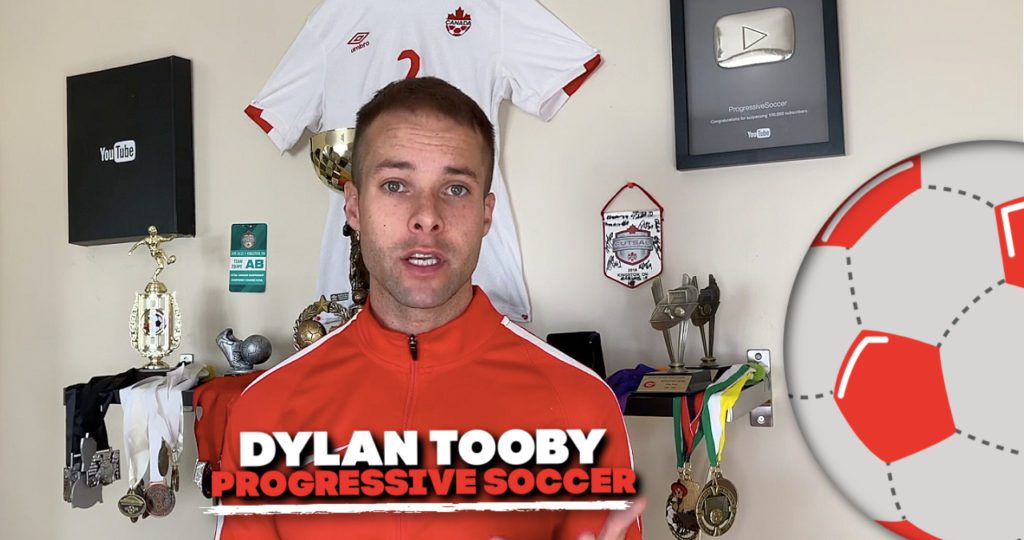
But enough about me, let’s focus on you.
If you’re looking to improve your skills, let’s take your soccer game to the next level. I want to help you make a noticeable change in style of play and overall performance on the field.
I’m passionate about helping players achieve their goals in soccer, and I’d love to be a part of your journey. I can help you reach your goals faster and achieve more in this sport, but I won’t force you. If you’re ready to take the next step, here’s what I suggest you do:
1) Download The Soccer Success Planner (FREE)
2) Apply To The Online Soccer Academy (Limited Spots)

Related blog posts you might enjoy:
How To Play Soccer (FOR BEGINNERS)
How To Be A Good Soccer Player
Coach Dylan
Progressive Soccer
Thank you for reading this article:
10 RULES OF SOCCER: Basic Rules & Offsides Explained
